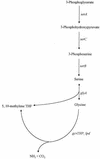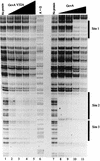Mutational analysis of the transcriptional regulator GcvA: amino acids important for activation, repression, and DNA binding
- PMID: 9733689
- PMCID: PMC107511
- DOI: 10.1128/JB.180.18.4865-4871.1998
Mutational analysis of the transcriptional regulator GcvA: amino acids important for activation, repression, and DNA binding
Abstract
The GcvA protein is required for both glycine-mediated activation and purine-mediated repression of the gcvTHP operon. Random and site-directed PCR mutagenesis was used to create nucleotide changes in gcvA to identify residues of the protein involved in activation, repression, and DNA binding. Single amino acid substitutions at L30 and F31 cause a defect in activation of a gcvT-lacZ fusion but have no effect on repression or DNA binding. Single amino acid substitutions at V32 and S38 cause the loss of binding of GcvA to DNA. A deletion of the carboxy-terminal 14 amino acids of GcvA results in the loss of purine-mediated repression and, consequently, a constitutive activation of a gcvT-lacZ fusion. The results of this study partially define regions of GcvA involved in activation, repression, and DNA binding and demonstrate that these functions of GcvA are genetically separable.
Figures




Similar articles
-
GcvA binding site 1 in the gcvTHP promoter of Escherichia coli is required for GcvA-mediated repression but not for GcvA-mediated activation.Microbiology (Reading). 2000 Nov;146 ( Pt 11):2909-2918. doi: 10.1099/00221287-146-11-2909. Microbiology (Reading). 2000. PMID: 11065369
-
Glycine binds the transcriptional accessory protein GcvR to disrupt a GcvA/GcvR interaction and allow GcvA-mediated activation of the Escherichia coli gcvTHP operon.Microbiology (Reading). 2002 Jul;148(Pt 7):2203-2214. doi: 10.1099/00221287-148-7-2203. Microbiology (Reading). 2002. PMID: 12101307
-
GcvA-mediated activation of gcvT-lacZ expression involves the carboxy-terminal domain of the alpha subunit of RNA polymerase.FEMS Microbiol Lett. 1999 Dec 15;181(2):307-12. doi: 10.1111/j.1574-6968.1999.tb08860.x. FEMS Microbiol Lett. 1999. PMID: 10585554
-
The cyclic AMP receptor protein is dependent on GcvA for regulation of the gcv operon.J Bacteriol. 1999 Mar;181(6):1912-9. doi: 10.1128/JB.181.6.1912-1919.1999. J Bacteriol. 1999. PMID: 10074087 Free PMC article.
-
Genetic analysis of the GcvA binding site in the gcvA control region.Microbiology (Reading). 1999 Aug;145 ( Pt 8):2153-2162. doi: 10.1099/13500872-145-8-2153. Microbiology (Reading). 1999. PMID: 10463182
Cited by
-
The Escherichia coli GcvB sRNA Uses Genetic Redundancy to Control cycA Expression.ISRN Microbiol. 2012 May 28;2012:636273. doi: 10.5402/2012/636273. Print 2012. ISRN Microbiol. 2012. PMID: 23724327 Free PMC article.
-
Mutational analysis to define an activating region on the redox-sensitive transcriptional regulator OxyR.J Bacteriol. 2006 Dec;188(24):8335-42. doi: 10.1128/JB.01318-06. Epub 2006 Sep 29. J Bacteriol. 2006. PMID: 17012382 Free PMC article.
-
The Salmonella enterica serovar Typhi LeuO global regulator forms tetramers: residues involved in oligomerization, DNA binding, and transcriptional regulation.J Bacteriol. 2014 Jun;196(12):2143-54. doi: 10.1128/JB.01484-14. Epub 2014 Mar 21. J Bacteriol. 2014. PMID: 24659766 Free PMC article.
-
Most mutant OccR proteins that are defective in positive control hold operator DNA in a locked high-angle bend.J Bacteriol. 2011 Oct;193(19):5442-9. doi: 10.1128/JB.05352-11. Epub 2011 Jul 29. J Bacteriol. 2011. PMID: 21804007 Free PMC article.
-
Structural and functional insights into transcription activation of the essential LysR-type transcriptional regulators.Protein Sci. 2024 Jun;33(6):e5012. doi: 10.1002/pro.5012. Protein Sci. 2024. PMID: 38723180 Free PMC article.
References
Publication types
MeSH terms
Substances
Grants and funding
LinkOut - more resources
Full Text Sources
Molecular Biology Databases

